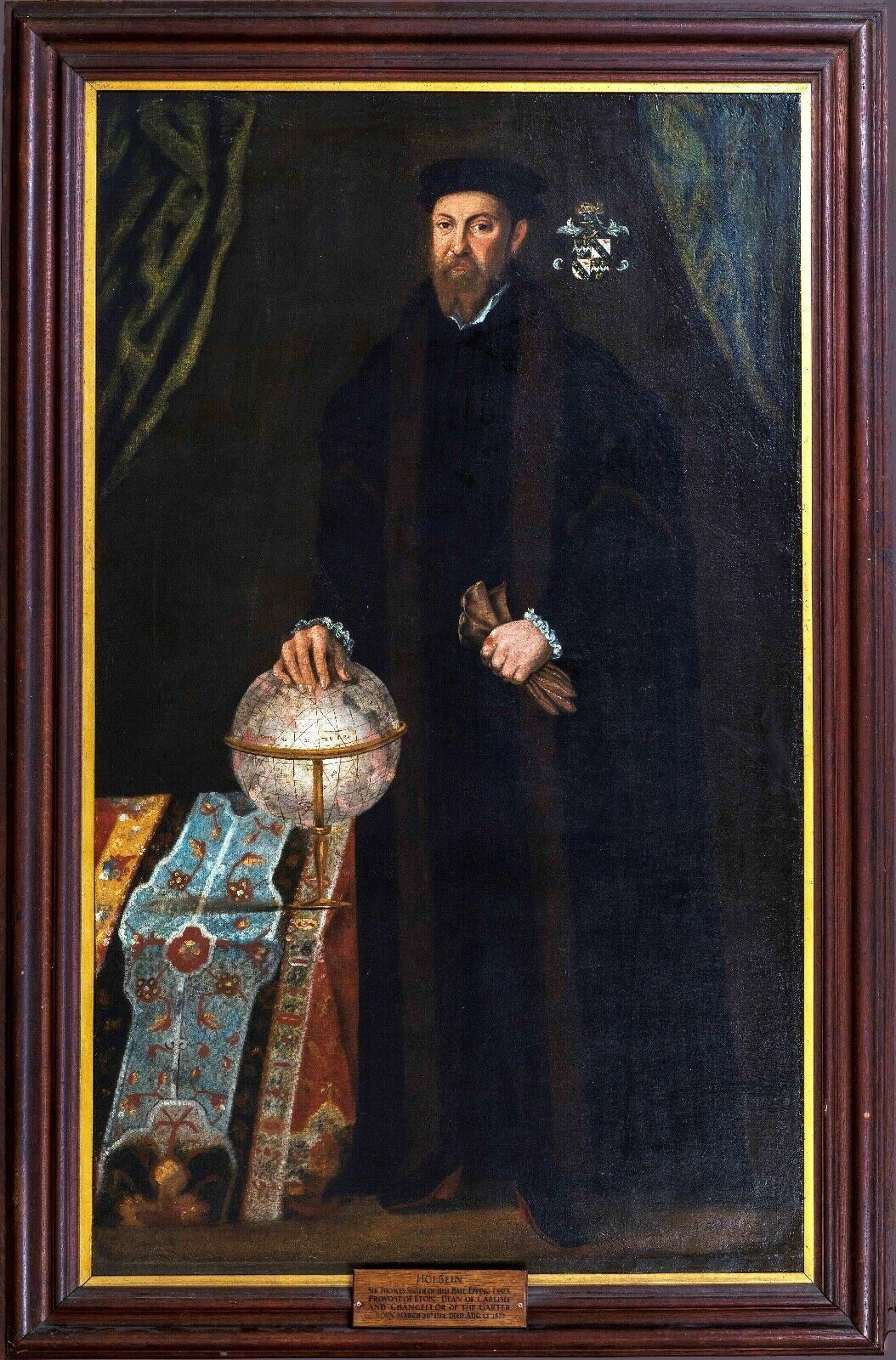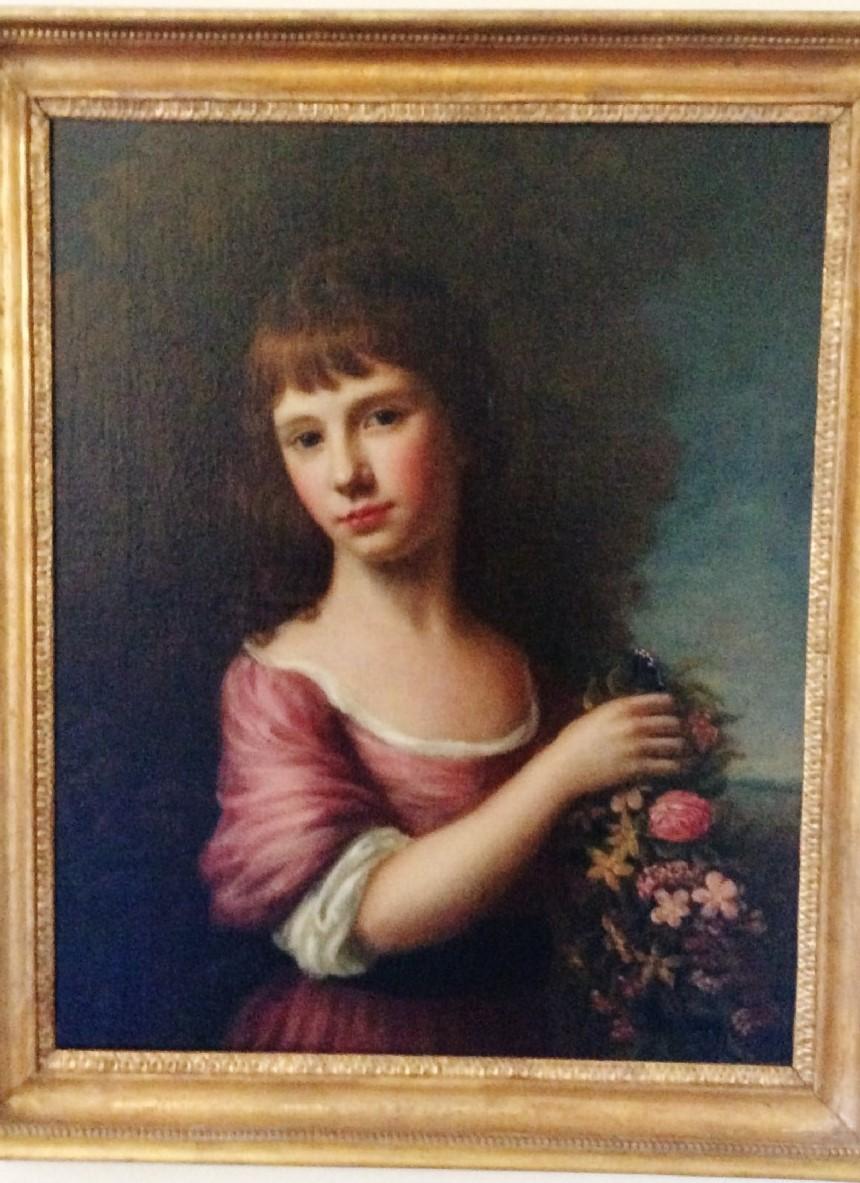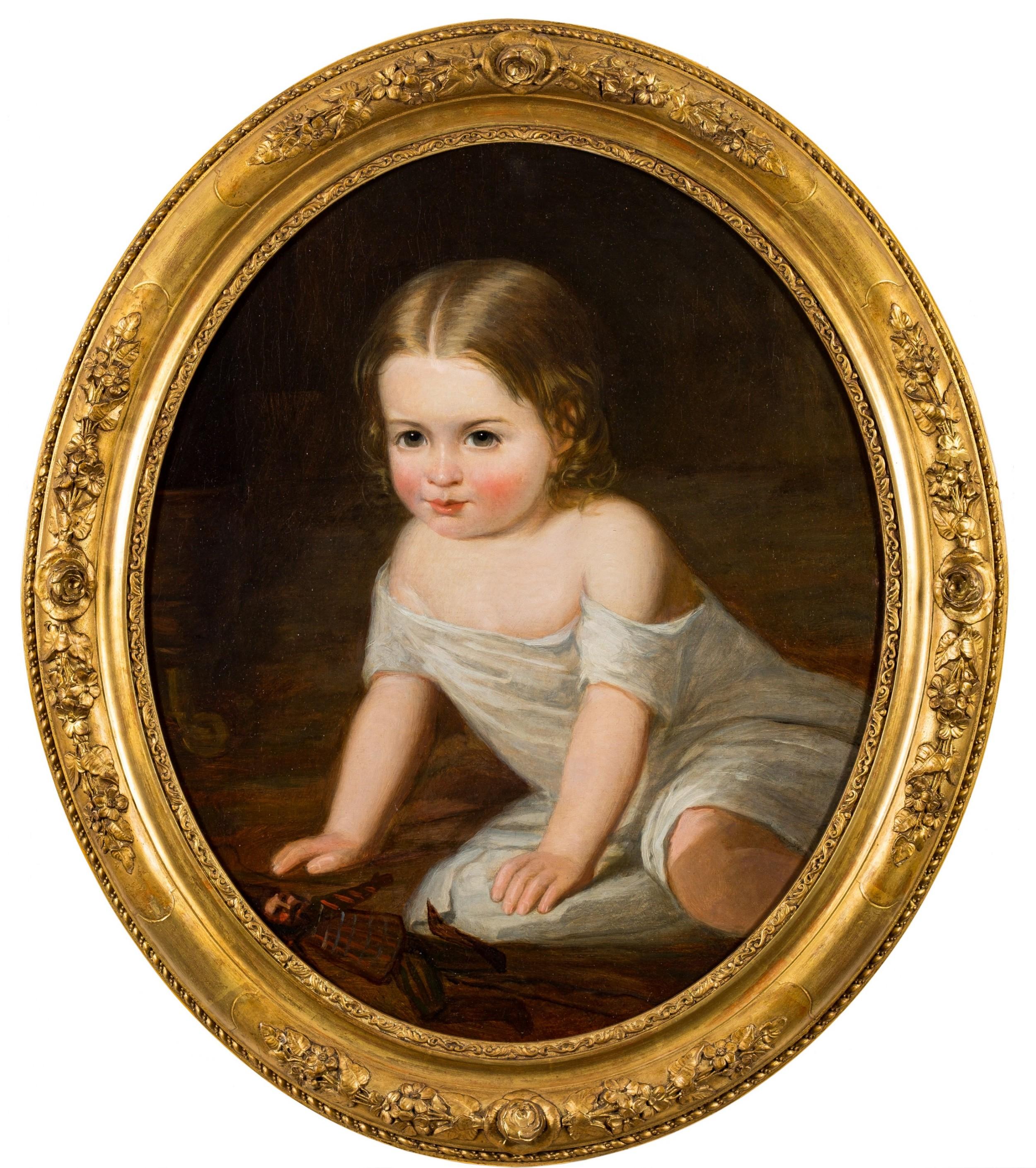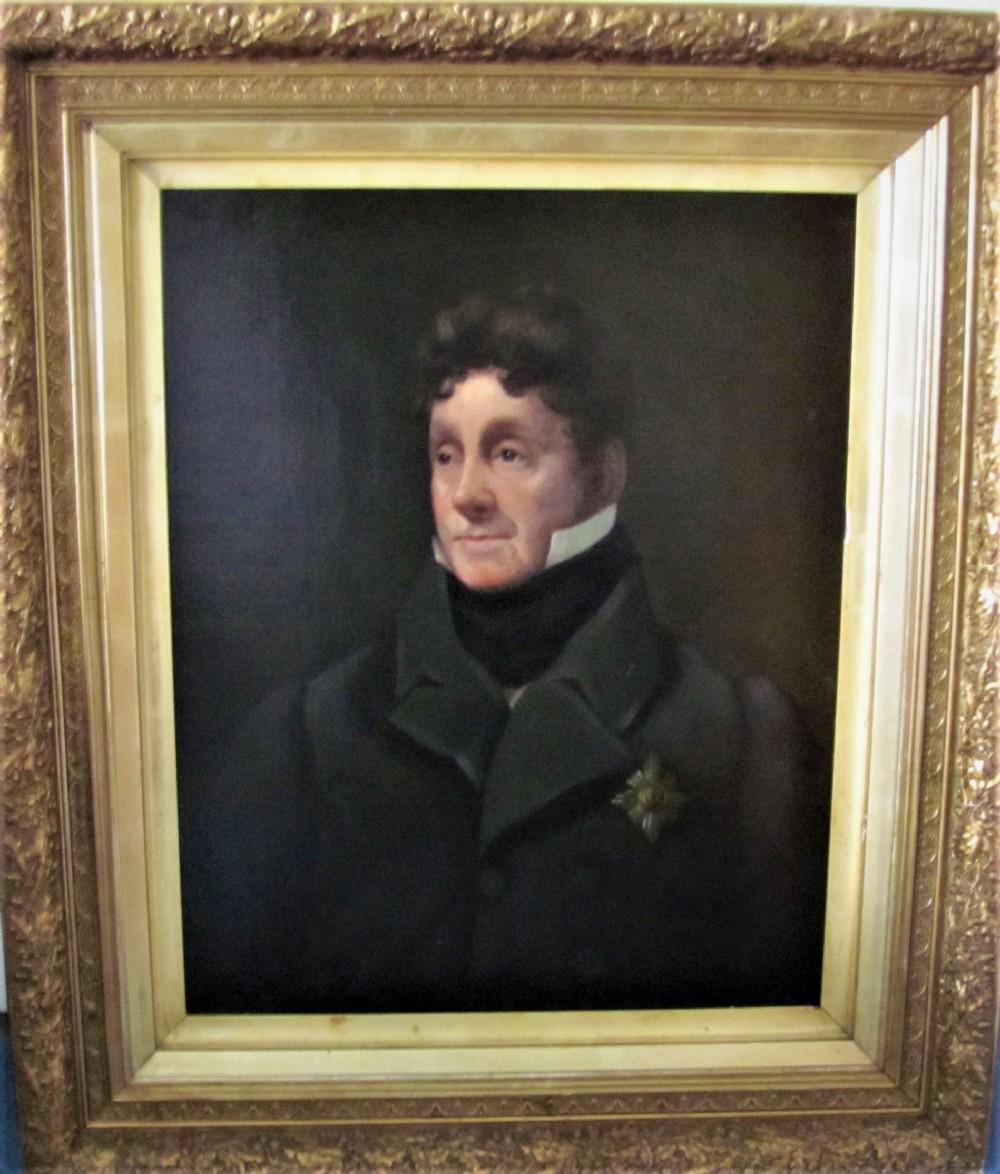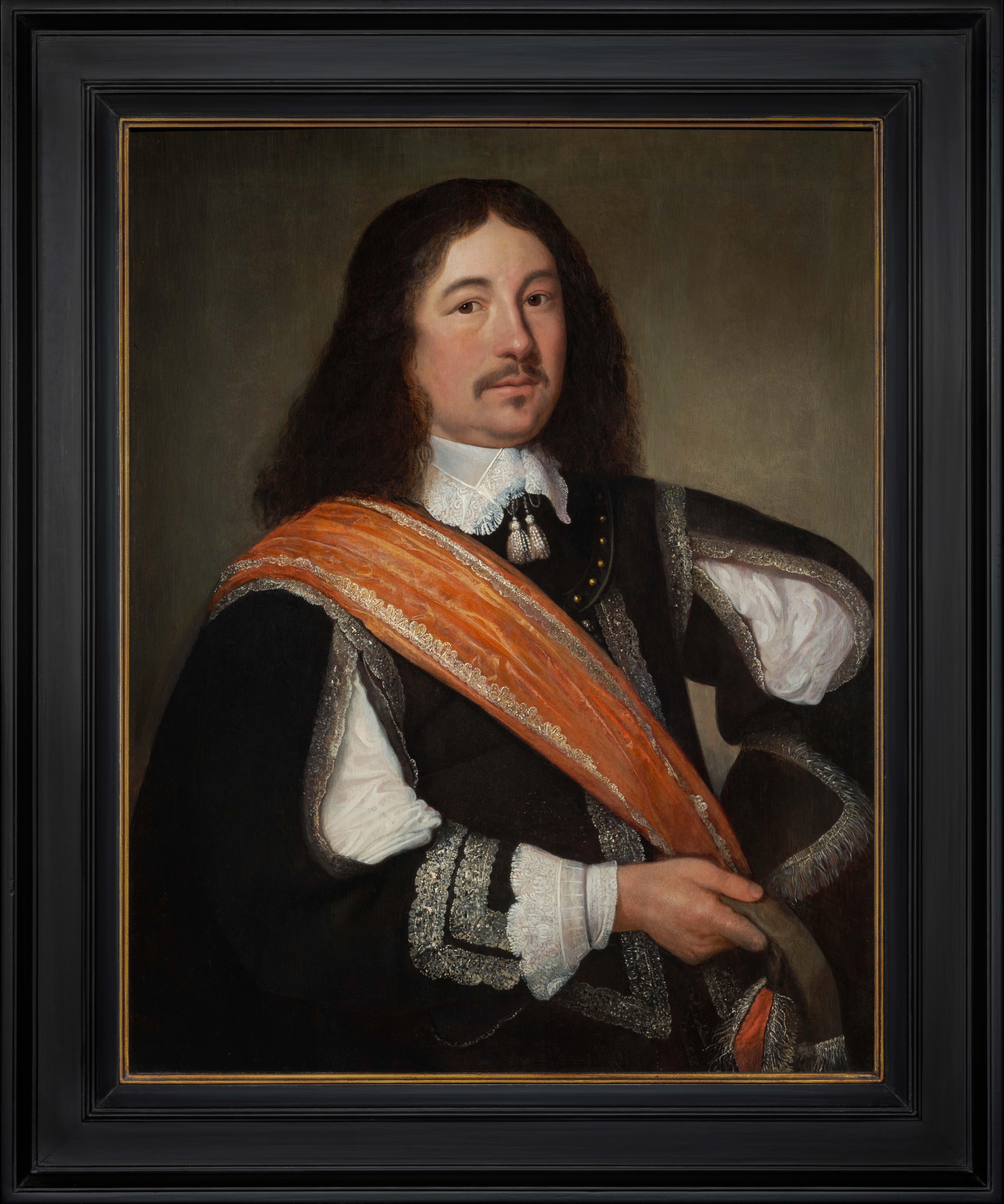Items Similar to Madonna Maria Piola Paint Oil on canvas 17/18th Century Old master Religious
Want more images or videos?
Request additional images or videos from the seller
1 of 18
Madonna Maria Piola Paint Oil on canvas 17/18th Century Old master Religious1670-1710
1670-1710
About the Item
Anton Maria Piola (Genoa, 1654 - 1715) circle
Madonna and Child
Genoese school of the second half of the 17th century
Oil on canvas
93 x 74 cm.- In antique frame 110 x 92 cm.
(Work with expertise by Dr. Arabella Cifani)
In the pleasing work proposed, depicting a classical Nativity scene, the Madonna is immortalised in adoration as she gently holds the sheet on which the Child is lying, with a gesture of protection and pride that facilitates an atmosphere of intimate recollection, in addition to the presence of three cherubs at the top.
The stylistic analysis of the canvas can easily be traced back to a painter of the Genoese school and active during the 17th century, specifically with the devotional works from the workshop of Domenico Piola (Genoa, 1627-1703), an absolute protagonist of Genoese Baroque culture.
Piola was the owner of the most important city painting workshop of the time, known as 'Casa Piola', where his sons Paolo Gerolamo and Anton Maria also collaborated.
His production, which specialised in a type of highly decorative, profane and allegorical paintings, destined for the decoration of Genoese patrician palaces, also included a refined series of works of a religious nature.
In particular, the style of our beautiful breast painting is close to that of his son Anton Maria Piola (Genoa, 1654 - 1715), who favoured intimate devotional compositions, and was a continuator of a family painting tradition clearly recognisable in the type of faces with gentle expressions, in the rendering of puffy and opaque drapery, in the tendency to flatten volumes and space, in the chromatic range that emphasises the prevalence of cold tones with a grey-blue dominant and makes the luministic apex coincide with the spatial centre of the scene, which in this case is the Child Jesus, who emanates light with his white robes and the grey-blue hues of the Virgin's dress.
ADDITIONAL INFORMATION:
The work is completed by a nice antique wooden frame and is sold with a certificate of authenticity and guarantee.
We take care of and organise the transport of the purchased works, both for Italy and abroad, through professional and insured carriers.
It is also possible to see the painting in the gallery in Riva del Garda, we will be happy to welcome you to show you our collection of works.
Contact us, without obligation, for any additional information.
- Creation Year:1670-1710
- Dimensions:Height: 43.31 in (110 cm)Width: 36.23 in (92 cm)
- Medium:
- Movement & Style:
- Circle Of:Anton Maria Piola (genoa, 1654 - 1715)
- Period:
- Condition:
- Gallery Location:Riva del Garda, IT
- Reference Number:1stDibs: LU988114128972
About the Seller
4.8
Platinum Seller
These expertly vetted sellers are 1stDibs' most experienced sellers and are rated highest by our customers.
Established in 2017
1stDibs seller since 2018
207 sales on 1stDibs
Typical response time: <1 hour
- ShippingRetrieving quote...Ships From: Riva del Garda, Italy
- Return PolicyA return for this item may be initiated within 7 days of delivery.
More From This SellerView All
- Terwesten Woman Allegory Art Paint Oil on canvas 17/18th Century Old masterLocated in Riva del Garda, ITMattheus Terwesten (The Hague, 1670 - 1757) Portrait of a young woman with palette and brushes, as Allegory of the art of Painting Oil on canvas 160 x 91 cm. - In frame 178 x 107 cm...Category
17th Century Old Masters Paintings
MaterialsOil
- Perroneau Portrait Lady Woman Paint Oil on canvas 18th Century Old master FrenchLocated in Riva del Garda, ITJean-Baptiste Perroneau (Paris, 1715 – Amsterdam, 1783) Portrait of a lady Oil on oval canvas 60 x 50 cm. - In frame 77 x 66 cm. Work accompanied by expertise: Raffaelle Colace (Cremona), Ferdinando Arisi Reference bibliography: d’Arnoult, Dominique (2014) Jean-Baptiste Perronneau, c 1715-1783, un portraitiste dans l’Europe des Lumières Excerpt from the expertise of Dr. Colace: This refined portrait of a lady is a perfect example of the style of Jean-Baptiste Perroneau, a very talented French painter, whose most beautiful works are located, just like this one, between the fifth and sixth decades of the eighteenth century. "Perroneaeu is more naturally colored than La Tour, the est, in the peinture de poussière colorée, tout plein de tons clairs, frais, presque humides": this is how his brothers wrote about him in La Maison d...Category
18th Century Old Masters Paintings
MaterialsOil
- Portrait Knight Paint Oil on canvas 17th Century Lombard school Old master ItalyLocated in Riva del Garda, ITLombard painter of the 17th century Portrait of a Knight in Armour Oil on canvas 81 x 70 cm./ Framed 93 x 82 A handsome gentleman in armour, immortalised in an authoritative and pr...Category
17th Century Old Masters Paintings
MaterialsOil
- Ecce Homo Coxie Paint 16/17th Century Paint Oil on table Old master Flemish ArtLocated in Riva del Garda, ITCircle of Michael Coxie (Malines, 1499 - Malines, 1592) Ecce Homo with Pontius Pilate Oil on panel Flemish school 16th-17th century 112 x 81 cm - framed 121 x 90 cm. The proposed p...Category
16th Century Old Masters Paintings
MaterialsOil
- Portrait Woman Princess Diziani Paint 18th Century Oil on canvas Old master ArtLocated in Riva del Garda, ITGaspare Diziani (Belluno 1689 - Venice 1767) Portrait of a Young Princess (Salome?) Oil on canvas 42 x 33 cm Framed 70 x 63 cm A charming portrait of a beautiful young woman with ...Category
18th Century Old Masters Paintings
MaterialsOil
- Cupid Portrait Parmigianino Paint 17/18th Century Oil on canvas Old master ItalyLocated in Riva del Garda, ITFollower of FRANCESCO MAZZOLA, known as IL PARMIGIANINO (Parma, 1503 - Casalmaggiore, 1540) Cupid Carving His Bow (as the triumph of love and desire over reason and knowledge) Oil o...Category
18th Century Old Masters Paintings
MaterialsOil
You May Also Like
- Portrait Of Thomas Smythe (1514-1577) School of Hans HOLBEIN (1497-1543)By Hans HolbeinLocated in Blackwater, GBPortrait Of Thomas Smythe (1514-1577), 16th Century School of Hans HOLBEIN (1497-1543) Fine huge 16th Century English Old Master portrait of Sir Thomas...Category
16th Century Old Masters Portrait Paintings
MaterialsOil
- William Wissing (follower) 19th Century Portrait Queen Mary IILocated in York, GBA 19th century oil on canvas, portrait of a young woman.This portrait is believed to be of Queen Mary II taken from an engraving of the painting, Halswell Park Sale, 1948, lot no.1323, Housed in a decorative gilt frame.Size overall being 70 x 86 cm high (27.5 x 33¾ inches approx) size of painting 54 x 68 cm (21 x 26 inches approx) To the rear of the portrait is a newspaper cutting of the engraving ,also a typed note regarding the provenance of the painting (see photo) Condition overall is very good, the Canvas has been relined, under UV there are areas of overpaint to bosom.Frame overall very good some minor self coloured losses Mary II (30 April 1662 – 28 December 1694) Mary, born at St James's Palace in London on 30 April 1662,eldest daughter of James, Duke of York (the future James II & VII) , and his first wife, Anne Hyde. Mary's uncle was King Charles II, her maternal grandfather, Edward Hyde, 1st Earl of Clarendon, served for a lengthy period as Charles's chief adviser. Mary married William of Orange. Willem Wissing, known in England as William Wissing...Category
19th Century Old Masters Portrait Paintings
MaterialsOil
- Nathaniel Hone, portrait of "flora" roman goddess, 18th centuryBy Nathaniel Hone the ElderLocated in York, GBI have great pleasure in offering for sale this beautiful portrait, by Nathaniel Hone, the elder. 18th century. The painting is of Ann Anderson, wife...Category
18th Century Old Masters Portrait Paintings
MaterialsOil
- 19th Century Portrait, Child At Play , Attributed To Henry Tanworth WellsLocated in York, GB19th century portrait, child at play ,Attributed to Henry Tanworth Wells A beautiful oval portrait of a young child at play, attributed to the portrait painter Henry Tanworth Wells. finely executed, this oil on canvas is in excellent condition. Housed in a period frame. The size overall is 79 cm x 62 cm whilst the painting is 56 cm x 46 cm Henry Tanworth Wells [1828-1903] Henry Tanworth Wells RA was an English miniature and portrait painter. He was a member of the Pre-Raphaelite circle though he painted in the academic style. His most popular painting...Category
19th Century Old Masters Portrait Paintings
MaterialsOil
- Henry Raeburn, (circle) 19th Century portrait of Sir Charles Forbes EdinglassieBy Henry Raeburn (circle)Located in York, GBPortrait of Sir Charles Forbes of Edinglassie, Oil on canvas. The size of the portrait is 75 cm x 59.5 cm whilst overall the size is 106 cm x 91 cm In very good condition.There has been some restoration/overpainting etc.There is some minor craquelure. Housed in a period gilt frame decorated with acorns and leaves Overall a good portrait, circle of a fine scottish artist , with an interesting sitter, his details below. sir Charles Forbes of Edinglassie Sir Charles Forbes, 1st Baronet (1774–1849) was a Scottish politician, of Newe and Edinglassie, Aberdeenshire. Forbes was the son of the Rev. George Forbes of Lochell. He was a descendant of Alexander Forbes of Kinaldie and Pitsligo, and was in 1833 served heir male in general to Alexander Forbes, 3rd lord Forbes of Pitsligo, father of Alexander Forbes, 4th Lord Forbes of Pitsligo, attainted in 1745. Forbes was of a bluff but kindly nature, diffident as to his own merits, of a straightforward and manly character. On the death of his uncle in 1821 Forbes succeeded to the entailed estates of the Forbeses of Newe, and was created a baronet by patent in 1823.[1] He married in 1811. His daughter, Elizabeth, married General, Lord James Hay, second son of the seventh Marquess of Tweeddale. Sir Henry Raeburn FRSE, RA, RSA (1756-1823) Scottish portrait painter and Scotland's first significant portrait painter since the Union to remain based in Scotland. He served as Portrait Painter to King George IV in Scotland Raeburn had all the essential qualities of a popular and successful portrait painter. He was able to produce a telling and forcible likeness; his work is distinguished by powerful characterisation, stark realism, dramatic and unusual lighting...Category
19th Century Old Masters Portrait Paintings
MaterialsOil
- Portrait Gentleman Black Coat Orange Sash, Dutch Old Master, Oil on Panel c.1650By Bartholomeus van der HelstLocated in London, GBThis exquisite portrait of a gentleman depicted in a sumptuous black coat edged with silver and slashed sleeves is an excellent example of the type of portrait fashionable in England and the Low Countries during the 17th century. The confident pose, striking orange sash - the colour of the house of Orange Nassau - and the leather gorget imbue the sitter with a sense of masculinity and power. The profusely decorated costume is of the highest quality and de rigueur of an elite class - the artist has carefully cultivated this portrait to emphasise the sitter’s wealth and standing in the society that he belonged to. The casual pose, with one arm resting on a hip, is much less formal than earlier decades, and it speaks of ‘sprezzatura’ – one’s appearance should not appear laborious, but instead, effortless. The oil on cradled panel portrait can be dated to circa 1650 based on the hairstyle and the attire - small falling collar, short doublet (doublets reduced in size to just below the ribcage in the late 1650’s), and the type of slashed sleeves with the sleeve seams left open to reveal the white fabric. The demand for portraits in the Netherlands was great in the 17th century. Bartholemeus van der Helst was considered to be one of the leading portrait painters of the Dutch Golden Age surpassing even Rembrandt as the most sought-after portraitist in Harlaam. The Dutch Golden Age, roughly spanning the 17th century, was a period when Dutch trade, science, military, and art were among the most acclaimed in the world. Dutch explorers charted new territory and settled abroad. Trade by the Dutch East-India Company thrived, and war heroes from the naval battles were decorated and became national heroes. During this time, The Dutch Old Masters began to prevail in the art world, creating a depth of realistic portraits of people and life in the area that has hardly been surpassed. The Golden Age painters depicted the scenes that their discerning new middle-class patrons wanted to see. This new wealth from merchant activities and exploration combined with a lack of church patronage, shifted art subjects away from biblical genres. Still life’s of items of everyday objects, landscapes, and seascapes reflecting the naval and trade power that the Republic enjoyed were popular. The new wealthy class were keen to have their portraits commissioned and many artists worked in this lucrative field. Such was the popularity of art that everyone had a painting, even the humble butcher, and hundreds of thousands of paintings were produced. By tradition the sitter is Maarten Tromp (1598-1653) who was an Admiral in the Dutch Navy (the reverse of the portrait contains an old handwritten inscription “van Tromp”). Certainly, the distinctive orange sash is similar to those worn by officers of the Dutch army in the Netherlands who served under the Princes of Orange and the House of Nassau. However, it should be noted that the physiognomy differs from other images of Tromp. Tromp was the oldest son of Harpert Maertensz, a naval officer and captain. He joined the Dutch navy as a lieutenant in July 1622 and was later promoted from captain to Lieutenant-Admiral of Holland and West Frisia in 1637. In 1639, during the Dutch struggle for independence from Spain, Tromp defeated a large Spanish fleet bound for Flanders at the Battle of the Downs, which marked an enormous change - the end of Spanish naval power. He was killed in action during the First Anglo-Dutch War in 1653 where he commanded the Dutch fleet in the battle of Scheveningen. Gloves were an absolutely vital accessory and the elaborate pair in this portrait are embellished with threads of silk and precious metals and salmon-coloured lining. He wears only one glove and holds the other, providing an opportunity to better display the cuffs and detail on his right wrist and forearm. The gloves are probably made from the most prized leather which came from Spain, in particular from Cordova. Cordovan leather was tanned with a special vegetal process that left it both highly impermeable and divinely soft. King Charles I, posed in a rather relaxed manner for Daniel Mytens’s portrait in 1631, is wearing gloves and boots in matching Cordovan leather. The hide is thick, but you can see just how supple it is from the way the gauntlet dimples and the long boot legs fold over themselves, rippling and wrinkling at the ankles. Apart from keeping hands warm the use of gloves during the 15th through the 19th centuries were full of symbolism and they were worn regardless of the season. They kept the skin unblemished - soft, smooth hands were considered highly attractive. This combination of necessity and proximity to bare skin made gloves a deeply personal gift and they took on a strong symbolic significance and were regarded as emblematic of fidelity and loyalty for hundreds of years. Such was the importance of their symbolism was that some gloves were never intended to be worn at all. Their luxury made them ideal gifts at court, and so in the 15th and 16th centuries, ambassadors often presented them as symbols of loyalty. Until the mid-19th century, it was customary to give gloves as tokens to guests at weddings and to mourners at funerals. Gentleman often gifted their bride-to-be with a pair of gloves (the obligatory gift) and were handed over at the betrothal and put on display before the wedding took place. It was probably their direct contact with the skin that led to the eroticism of gloves. Not only were pairs often exchanged between lovers, but from the 16th to the 18th centuries, it was common practice to remove one glove and give it as a gift to a favourite. The idea of the item being presented still warm from the wearer’s hand is certainly suggestive. Following the death of King George IV, his executors purportedly found over a thousand mismatched ladies’ gloves among his possessions. The sentiment of a 17th-century poem reveals the popularity of the practice: “Come to our wedding to requite your loves / Shew us your hands and we’ll fit you with gloves.” Such generosity might be pricey for the hosts, but gloves of varying quality could be offered depending on the status of the recipient. Pairs made with the finest Spanish leather might be reserved for immediate family, while coarse sheep’s leather could be distributed among the servants and tradesmen. The apportioning of quality according to class provided a very clear message of the gloves’ intended use. For refined guests, they were decoration; for the lower classes, they were functional. Bartholomeus van der Helst...Category
17th Century Old Masters Portrait Paintings
MaterialsOil, Wood Panel
Recently Viewed
View AllMore Ways To Browse
Old Style Paintings
17 Century Painting
18th Century Old Masters
Religious Art Italy
Old Master Scene
Antique Old Painting
Religious Framed Art
Oil Paintings 17 Century
Old Antique Religious Art
Framed Religious Painting
Old Master Style Oil Painting
Old Antique Dresses
Oil On Canvas Religious
Old Paintings 17 Century
Italian School Old Master
Three Marias Art
18th Century Old Master Oil Painting
Antique Religious Oil
